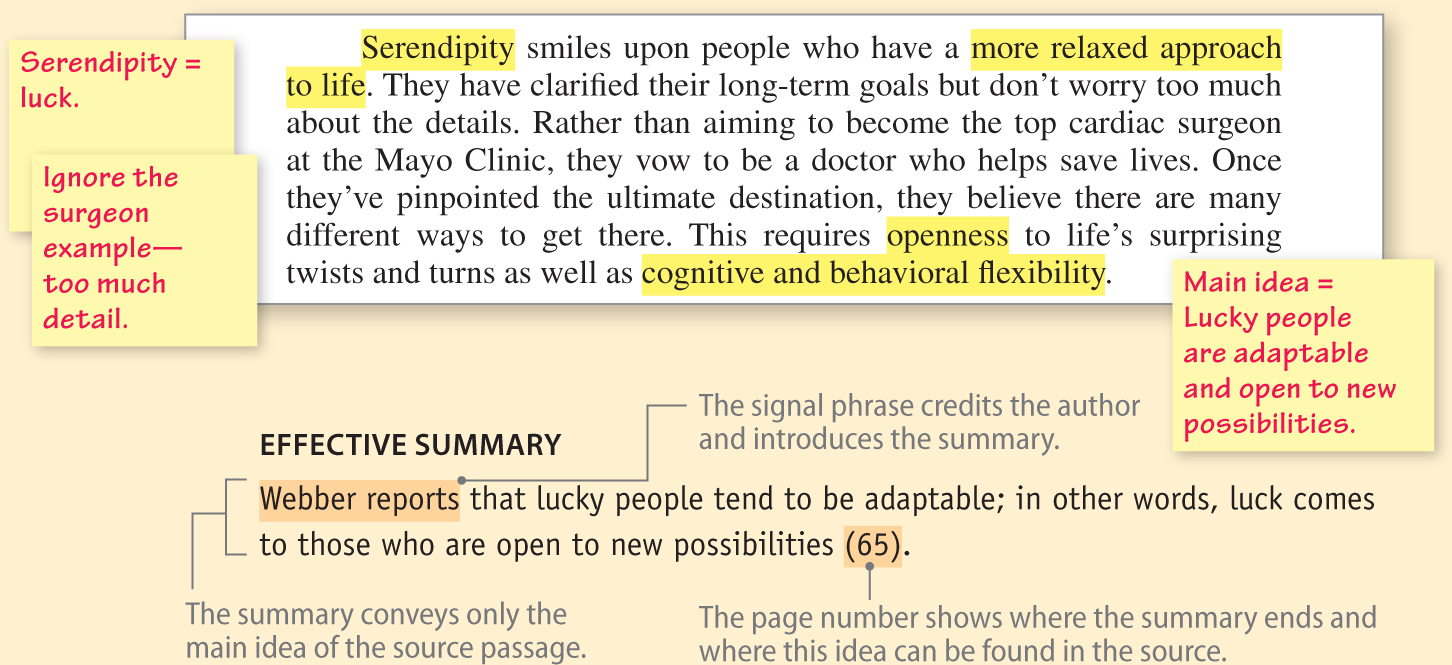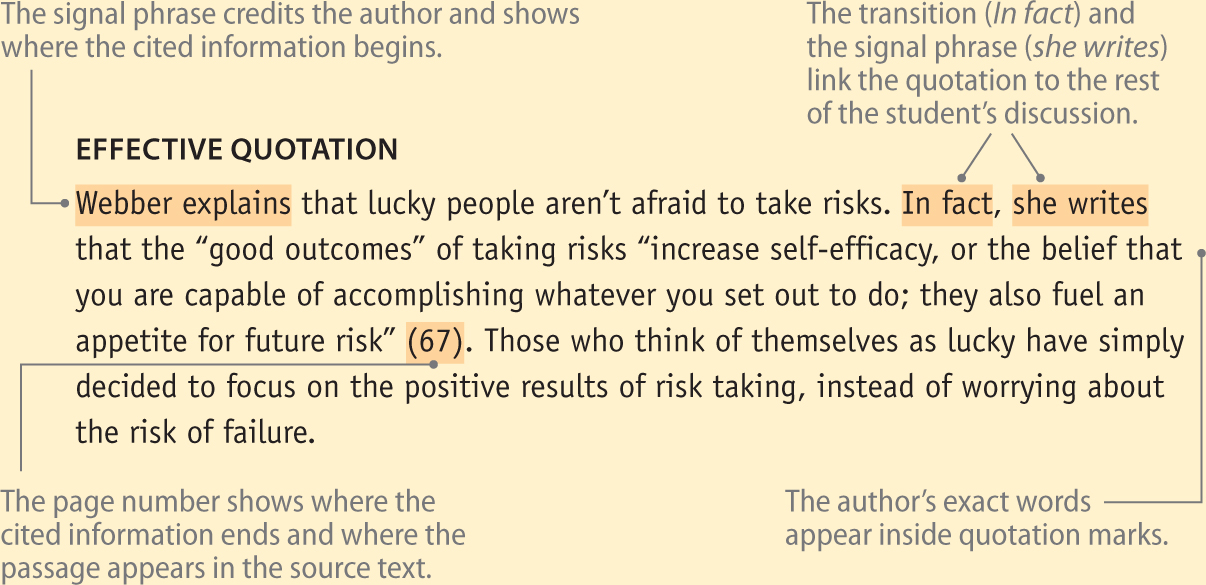E3-d: Recognizing intellectual property and avoiding plagiarism
In the United States, the exact language, images, and original ideas contained in any published work are considered intellectual property, which is legally protected as if it were physical property. When you write papers for your college classes, your instructors will expect you to give credit whenever you include an author’s intellectual property in your own paper. You credit the author by citing your sources (see MLA-2). If you do not properly cite your sources, you might unintentionally commit a form of academic dishonesty called plagiarism. Most colleges in the United States take plagiarism very seriously: If a student plagiarizes, even accidentally, the student might fail the assignment or the course.
Recognizing intellectual property
Knowing what is and isn’t intellectual property can be difficult. When you are writing a research paper or any essay that includes ideas from other authors, you can use the chart below to help you determine whether those ideas are someone else’s intellectual property. If you need additional help, review a draft of your paper with your instructor or a tutor at your school’s writing center. It is important that you catch any accidental plagiarism before you turn in your work.
Avoiding plagiarism by integrating and citing sources
When you use other writers’ ideas in your paper, you must follow standard academic conventions for citing, or giving credit to, the authors—a practice called integrating sources. There are three methods for integrating sources in your paper: summarizing, paraphrasing, and quoting. At times, you might combine these methods to present an author’s ideas.
The chart below shows how to summarize, paraphrase, and quote from a source. For more on writing with sources, see “integrating sources” and “citing sources” in your handbook. Remember that whenever you summarize, paraphrase, or quote other sources in your paper, you must also provide a list of those sources at the end of your paper. This list is called Works Cited in MLA style, References in APA style, and Bibliography in CMS (Chicago) style. For details, see MLA-4, APA-4, or CMS-4.
Integrating and citing sources
Summarizing, paraphrasing, quoting, and documenting
The following annotated source passages and sample summary, paraphrase, quotation, and MLA-style citation show how one student thought about and integrated a source into a paper for an introduction to psychology course.
Summarizing
When you summarize a source, you express another author’s ideas in your own words, using fewer words than the author used. Even though a summary is in your own words, the original idea remains the intellectual property of the author, so you must include a citation.
To summarize effectively, try annotating the source text to identify the focus of the passage. Then, using your own words, present the main idea or ideas, leaving out detailed illustrations and examples.
original source passage (webber, “make your own luck,” 65)

Paraphrasing
When you paraphrase, you express an author’s idea in your own words, using approximately the same number of words as in the source. Even though the words are your own, the original idea is the author’s intellectual property, so you must give a citation.
original source passage (webber, “make your own luck,” 66)


Because the sentence structure and phrasing are too similar to those of the original, the attempted paraphrase is plagiarized. This student has merely replaced a few of the author’s words with synonyms. Gives us a narrow view is too similar to gives us tunnel vision. Potentially helpful information is almost the same as potentially beneficial information.
To paraphrase effectively, be sure that you thoroughly understand the source text. After you have read the passage you want to paraphrase, set the source aside. State in your own words the author’s key ideas. Then look at the source again to be sure that you haven’t used the author’s exact words or sentence structure.

The revised paraphrase conveys the author’s original idea but uses the student’s voice. No phrases are plagiarized.
Quoting
When you quote a source, you copy some of the author’s exact words and enclose them in quotation marks. Quotation marks show your readers that both the idea and the words belong to the author.
To quote effectively, give your readers enough information to understand how the quotation relates to your own ideas. Introduce the quotation in your own words and then explain it so that your readers understand its significance.
original source passage (webber, “make your own luck,” 67)


After quoting the author’s exact words, the student writer discusses the quotation.
Documenting
To give proper credit to any sources you summarize, paraphrase, or quote, you must provide complete citation information on the works cited page at the end of your paper. (For more about citing sources, see the MLA, APA, or CMS (Chicago) section in your handbook.)
sample entry in an mla works cited list
Webber, Rebecca. "Make Your Own Luck." Psychology Today, June 2010, pp. 62-68.
Recognizing intellectual property
Intellectual property
The first column shows the types of information that are considered intellectual property. The second column gives examples from student essays that use and cite sources with the MLA style of documentation (used in English and some humanities). See the MLA section of your handbook for complete details about citing sources in your paper and in the list of works cited in MLA style. See the APA section or the CMS (Chicago) section of your handbook if your instructor or discipline requires one of those styles instead.
| Type of information | Examples with appropriate citations |
| Any exact words from a published source (even if the source provides a fact) |
in-text citation Luis N. Rivera writes, “Five hundred years ago, thanks to the nautical audacity and cosmographical ignorance of an Italian mariner . . . the Atlantic Ocean ceased to be a divider and became the waterway connection between Europe, Africa, and the Americas” (270). works cited entry Rivera, Luis N. A Violent Evangelism. Westminster, 1992. |
| Any original ideas from a published source—even if you’ve paraphrased the source (written the information in your own words) |
in-text citation Historian Paul Gordon Lauren shows that even though the First World War did not seem to be about race at first, a number of racial issues had surfaced by the time the war ended in 1918 (75). works cited entry Lauren, Paul Gordon. Power and Prejudice. 2nd ed., Westview, 1996. |
| Results of a study |
in-text citation One study showed that cutting down trees that have been burned in forest fires prevents new trees from growing in the area (Donato et al. 352). works cited entry Donato, D. C., et al. “Post-Wildfire Logging Hinders Regeneration and Increases Fire Risk.” Science, vol. 311, no. 5759, 2006, p. 352. |
| Type of information | Examples with appropriate citations |
| Statistics |
in-text citation Gore writes, “In 1988, the EPA reported that the ground water in thirty-two states was contaminated with seventy-four different agricultural chemicals, including one, herbicide atrazine, that is classified as a potential human carcinogen” (xxii-xxiii). works cited entry Gore, Al. Introduction. Silent Spring, by Rachel Carson, Houghton Mifflin, 1994, pp. xv-xxvi. |
| Theories |
in-text citation While many linguists have argued that language is a “cultural invention,” Steven Pinker claims that language is an “instinct”; he writes that it is “not a cultural artifact” but “a distinct piece of the biological makeup of our brains” (4). works cited entry Pinker, Steven. The Language Instinct. Perennial, 2000. |
Not intellectual property
The first column shows the types of information that are not considered intellectual property and that may be used in a paper without citing a source. The second column gives examples of each type.
| Type of information | Examples |
| Well-known historical, scientific, or cultural facts | Christopher Columbus sailed across the Atlantic Ocean in 1492. World War I ended in 1918. Forest fires are sometimes caused by lightning. Rachel Carson wrote Silent Spring. |
| Broad, general observations | Many languages are spoken in the United States. Some students tend to have more motivation than others. Many US residents own cars and computers. |
note: For types of information not on this list, check with your instructor or your school’s writing center to determine whether you need to cite the source. When in doubt, cite the source.